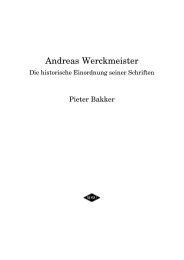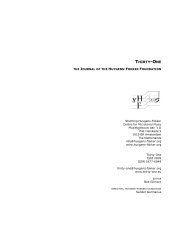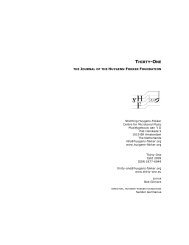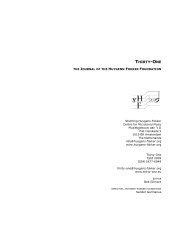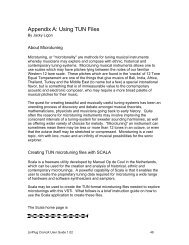Recent Organ Design Innovations and the 21st-century - Stichting ...
Recent Organ Design Innovations and the 21st-century - Stichting ...
Recent Organ Design Innovations and the 21st-century - Stichting ...
You also want an ePaper? Increase the reach of your titles
YUMPU automatically turns print PDFs into web optimized ePapers that Google loves.
Advancements in keyboard design <strong>and</strong> console interfacing allow organists previously<br />
unparalleled control over new modes of expression <strong>and</strong> music-making, including <strong>the</strong> highly effective<br />
keyboard design permitting efficient <strong>and</strong> virtuosic comm<strong>and</strong> of seven-limit just intonation designed by<br />
Adriaan Fokker; intuitive button arrays, switches <strong>and</strong> dials permitting dynamic control of wind pressure<br />
on <strong>the</strong> Bares organ in Cologne; <strong>the</strong> ability to quickly create novel mixtures <strong>and</strong> sound combinations on<br />
<strong>the</strong> both <strong>the</strong> Bares organs <strong>and</strong> Modulorgue; <strong>and</strong> <strong>the</strong> digital control over pipe speech on <strong>the</strong> Modulorgue.<br />
Similarly, <strong>the</strong> Kraul prototypes offer efficient haptic control of wind pressure, pipe speech <strong>and</strong><br />
resonance, <strong>and</strong> pitch <strong>and</strong> dynamic fluctuation. In addition, such electronic interfacing invites new<br />
genres of multi-instrumental or computer collaboration, as well as endless possibilities among new<br />
modalities of direct performance by agents removed from <strong>the</strong> organ keyboards. Advances in this kind of<br />
interfacing may hold <strong>the</strong> key for resurgence in <strong>the</strong> organ’s esteem among art music in <strong>the</strong> <strong>21st</strong> <strong>century</strong>.<br />
Technologies such as NovelOrg, when used in conjunction with a traditional mechanical action or an<br />
innovative action of <strong>the</strong> type found on <strong>the</strong> Kraul organs, hold tremendous promise by securing <strong>the</strong><br />
future of expressive mechanical action while permitting myriad possibilities for finely controlled electro-<br />
acoustic interfacing of <strong>the</strong> type found on <strong>the</strong> purely-electric Modulorgue.<br />
The dramatic advances in <strong>the</strong> speed <strong>and</strong> power of personal computing over <strong>the</strong> past two<br />
decades have propelled computer composition featuring live manipulation of performance sound into a<br />
principal force in new music. However, <strong>the</strong> organ’s profile among <strong>the</strong> electro-acoustic composition<br />
movement has until now remained minimal. The application of integrated electronic interfacing as I<br />
have been discussing, in addition to <strong>the</strong> inclusion of o<strong>the</strong>r electronic components <strong>and</strong> software, working<br />
in conjunction with this new found control over microtonal pitch fluctuation <strong>and</strong> spectral soundscape<br />
could make <strong>the</strong> organ an ideal vehicle for electro-acoustic composition in <strong>the</strong> <strong>21st</strong> <strong>century</strong>. In contrast<br />
to purely electronic composition or composition for acoustic instruments accompanied by prearranged<br />
electronic sounds, <strong>the</strong> primary interest among contemporary electro-acoustic composers lies in <strong>the</strong> use<br />
40



